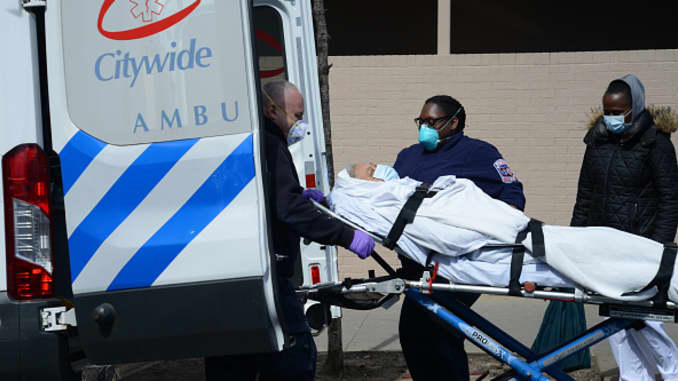Here’s what you need to know when it comes to paying for coronavirus treatment
- The average cost to treat a hospitalized patient with coronavirus is $30,000, according to a study.
- Regardless of the amount, the tab wouldn’t be picked up entirely by patients with insurance.
- Even if you don’t have coverage, you may not end up getting billed for all your treatment due to the Trump administration’s intention to partially reimburse providers for treating the uninsured.
The last thing someone who contracts coronavirus needs to worry about is the cost of treating it.
While legislators, regulators and insurance companies have taken steps aimed at improving access to care and reducing expenses, one person’s required share of medical charges could vary wildly from another patient receiving the same treatment.
Most individuals who come down with the virus recover at home.
However, an estimated 15% of infected people may end up hospitalized, according to the Kaiser Family Foundation. Recent data suggests that patients who go to intensive care stay there for an average of 20 days.

The average cost to treat a hospitalized patient with the virus is $30,000, according to a study released Wednesday by America’s Health Insurance Plans, a trade group for insurers. (Other estimates have come in both lower and higher.)
Regardless of the amount, though, the tab generally wouldn’t be the responsibility of patients with insurance. And even for those with no coverage, there’s a good chance — as of now — that you won’t get billed for at least som eparts of your treatment.
Here’s what you should know.
The uninsured
Although details are still being worked out, the Trump administration said last week that it will use funding under recently passed legislation to help cover the cost of treating uninsured coronavirus patients — as long as the hospital accepting the government’s reimbursement rate does not bill the uninsured patient for any remaining balance (i.e., “balance billing”).
“The uninsured would be able to go into the hospital without being worried about facing thousands of dollars in hospital bills,” said Karyn Schwartz, a senior fellow at the Kaiser Family Foundation.
However, it’s unclear whether the government’s offer of reimbursement extends only to hospitals or to other providers as well, Schwartz said. That includes physicians who treat a coronavirus patient in the hospital and may not be directly employed by the facility.

If it does apply to all coronavirus-related treatment in a hospital, and there’s broad acceptance by providers to accept the conditions of getting the money, the cost for an uninsured patient could be next to nothing — meaning they could fare better than some insured patients.
“For a Covid-19 patient whose insurer is not covering cost-sharing the way some are, they might be somewhat worse off than an uninsured person who would be getting help from the government,” said Paul Ginsburg, director of the USC-Brookings Schaeffer Initiative for Health Policy.
There are roughly 28 million uninsured individuals in the U.S., according to Kaiser. Of those, an estimated 670,000 to about 2 million will require hospitalization for coronavirus.
Private health insurance
Not counting any Medicare plans, this category generally includes employer-based insurance options as well as individual policies purchased through a health exchange or marketplace.
Although some of the nation’s largest insurers have said they’ll waive cost-sharing — i.e., deductibles and co-pays — for treatment, some employer plans can choose not to participate.
Basically, in plans that are “self-funded” — typically more common among large employers — cost-sharing is determined by the company, not the insurance carrier.
“You might have, say, an Aetna or United Healthcare insurance card, but they are just the administrator of the plan and not the one making the rules,” Schwartz said.
If your employer plan isn’t among those that’s waiving treatment costs, typical co-pays and deductibles would apply. The average deductible among employer plans is $1,655. For non-group policies purchased through an exchange, the deductible typically is higher: more than $4,500 for an individual and nearly double that for family coverage.
About 157 million people had employer-based plans as of 2018, according to Kaiser data. Another 20 million had individual policies.
Medicare and Medicaid
For the 62 million people on Medicare — the majority of whom are 65 or older, the others younger with disabilities — the cost for coronavirus treatment would depend largely on whether the beneficiary has additional insurance beyond basic Medicare (Part A hospital coverage and Part B outpatient care coverage).
Roughly a third of Medicare recipients have an Advantage Plan. Many of the plans — which deliver Parts A and B, and typically prescription drug coverage — have their own cost-sharing structures. Some insurers who offer those plans have said they will waive treatment costs.
And, regulators have alerted Advantage Plans that operate in states with emergency declarations in place that they must cover services at out-of-network facilities (that participate in Medicare) and charge the in-network rate.
Other beneficiaries pair basic Medicare with a supplemental policy (i.e., Medigap), which would end up covering much of the cost-sharing that comes with original Medicare, including deductibles and co-pays.
By signing up for newsletters, you are agreeing to our Terms of Use and Privacy Policy.
However, for those with basic Medicare and no additional coverage — whether through Medicaid, an employer plan or elsewhere — the cost-sharing hasn’t changed.
“There’s been no additional protections added for them,” Schwartz said. “They’re kind of stuck.”
Those recipients would face a $1,408 Part A deductible when they’re admitted to the hospital, although that covers the first 60 days of hospitalization.
For patients on Medicaid — roughly 65 million people whose incomes are low enough to qualify for that program — the cost-sharing for medical care is typically minimal, although it varies from state to state.
